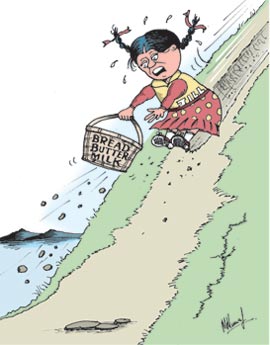The good news for consumers is that prices are coming down. That is not quite correct, but it is this tricky statistic that confuses people. When the Central Bank announced that “Inflation falls further to a five years’ low of 0.7%”, it did not mean that prices are coming down. What it means is that prices are going up but at a lower rate than before. Prices are decelerating compared to what they were; they are not decreasing. The rate of increase in prices is at a much lower rate than in recent years when we experienced very high rates of inflation. Nevertheless it is good news especially as we have experienced very high increases in prices in recent times.
 |
The general reaction to an announcement of the rate of inflation decelerating, is whether the figure is correct. “Are prices really going down? Do you believe that prices of the things we buy have gone down?” is a common reaction to such an announcement. If the statistic is put across in a different manner it would be more credible. For instance, if it is said that ‘prices have gone up but at a lower rate than before’, then there would be a better understanding of what has happened.
In any event it is indeed good news for consumers and the economy in general that the rate of increase in prices has fallen. This deceleration in prices is also quite significant, and according to the Central Bank the lowest level of increase in prices in the last five years. This decrease in the increase in prices to 0.7 per cent in September, 2009 is part of the recent trend of deceleration in prices. In the previous month, (August 2009) too it had fallen to 0.9 per cent. This trend in lower price increases is bringing down the annual inflation rate. The trend in price deceleration has been maintained since November, 2008. The twelve month increase in prices till September this year declined further to 6.6 per cent compared to 8.5 per cent in the preceding month.
The annual average inflation rate also continued on a decelerating path observed since November, 2008 and declined further to 6.6 per cent compared to 8.5 per cent in the preceding month. It is very likely that the rate of inflation for this year would be a single digit. Unless some unforeseen increases in prices occur, the rate of inflation is likely to be below 8 percent. This expected annual rate of inflation of below 10 percent compares very favourably with those of previous years. The average annual rate of inflation for the previous five years (2004- 2008), calculated in the same manner was 12 percent. The rates of inflation for 2007 and 2008 were 15.8 and 14.4 respectively. This comparison indicates that the trend in price increases has been reversed.
There is little doubt that price increases have declined, but it does not mean that prices are decreasing. They are increasing but at a lower rate. High rates of inflation affect consumers and producers adversely. Often high consumer prices result in political unpopularity. In India it is said that a rate of inflation of over 5 percent is politically unsustainable. Elections during times of high inflation have seen incumbent governments fall. The government in Sri Lanka has retained its popularity and won a series of provincial government elections despite the high rate of inflation owing to the war with terrorists in the first instance and then the victory. Therefore the high rate of inflation has tended to not affect the vulnerability of the party in power. Now that the rate of inflation has decreased it may not be a factor affecting the political fortunes of the incumbent government. Yet one must not forget that recent high price increases have hurt the living standards of the poor.
The prices of essential basic items are high. Although their rate of increase has declined, the costs of living of the poor and middle classes remain high. It is food price inflation that is of most serious concern to the poor. In recent times the proportion of income spent on food and other basic items like, transport, fuel, gas and electricity has been very high and a severe burden. Inflation also affects the country’s export competitiveness. When prices increase, the costs of production of export commodities increase. If the increase in the costs of production in Sri Lanka rise more than those of countries competing with us for export markets, our exports could become less competitive. This is a serious situation for the country as it is very dependent on its exports for imports. The country remains an import export economy whose trade dependency is as much as around 70 percent of GDP. It is therefore essential that the price level is kept reasonably stable.
It must also be kept in mind that the price increases that affect production costs are somewhat different to those measured by the consumer price indices. The costs of energy, transport, fuel and raw materials are what matters. Wages are a most important factor in the costs of production of most exports and wages are affected by increases in consumer prices. The recent increase in wages of plantation workers is illustrative of this.
Despite the decreasing trend in price increases, the poor are in dire straits to meet their basic living expenses. Reduction in prices of basic items of consumption must remain a priority. Stable prices are also important to retain the country’s international competitiveness in exports. Relatively higher rates of inflation would necessitate the depreciation of the currency that would bring in a wave of import led inflation. It is widely recognised that inflation hurts an economy. Reasonable stability in prices is considered a precondition for steady economic growth. It is therefore important that economic policies ensure price stability even when external factors are destabilising. The control of inflation is a far-sighted social, political and economic objective. |

